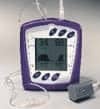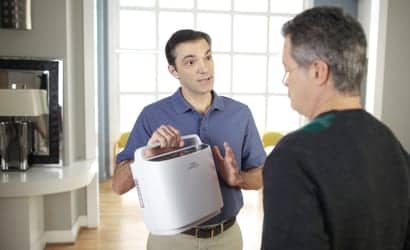RT students at the Louisiana State University Health Sciences Center are taught to be critical thinkers.

At Louisiana State University (LSU) Health Sciences Center in New Orleans, respiratory therapy students learn to use more than ventilators and arterial blood-gas machines. They also learn to use their brains.
“We put a premium on training our students to engage in critical thinking,” says John Zamjahn, MHS, RRT, RCS, RCIS, instructor of cardiopulmonary science. “We don’t want them just knowing how to follow orders and do charting. We want to help them develop in themselves the skill to use knowledge and applied reasoning so as to be able to make good recommendations—and decisions.”
Zamjahn (pronounced zahm-YON) explains that respiratory therapists in today’s critical care environments no longer can rely on the formulaic approaches of the past if they want to be considered top-notch practitioners capable of delivering high-quality, outcomes-driven yet cost-effective service.
“Patients are always going to present with different symptoms and signs that sometimes don’t fit within any kind of therapy cookbook,” he says. “It’s the job of the RT to put the signs and symptoms together the right way. Since there are always going to be exceptions to the rules, the larger your knowledge base and the more ability you have to think critically and know how to put together the pieces, the better the care the patient will receive.”
One way the school teaches critical thinking skills involves the use of exercises in which students gather facts about a case, evaluate the information, and then draw the right conclusions.
For example, they will present a contrived scenario in which a patient comes into the clinic with a complaint of chest pains and encourage students to explore potential causes. “That’s going to require knowing the right questions to ask so they can quickly rule out possibilities and narrow it down to a pulmonary or a cardiovascular condition,” says Zamjahn. “At the same time, they will have to be thinking about the tests that need to be run, what types of data need to be collected to determine whether those tests were appropriate, and what decisions should be made once that information is in hand. We want the students to think.”

Multi-Competent Therapists
Only applicants with strong grade-point averages and necessary course prerequisites qualify for consideration in the program, which is administered by LSU Health Sciences Center’s Department of Cardiopulmonary Science. “We typically have 12 to 20 students enrolled in it at any one time on our New Orleans campus,” says Zamjahn. A second school is at the LSU campus in Shreveport, La.
“Our school is one of the few in the nation to confer on respiratory therapists a bachelor’s degree—and that’s because our goal is to train therapists who have the ability and interest to go on to the next level, to not be run-of-the-mill therapists, to be prepared for their first job but also to be prepared for their job 5 to 10 years down the road,” says Kim Simmons, NPS, MHS, RRT-NPS, director of clinical education, a graduate of the program. “When you receive your diploma here, it means you’re multi-competent in respiratory therapy and cardiovascular technology.”
Students enter the program at the start of their junior year of undergraduate schooling, but must first have earned 60 credits in English composition, humanities, general and laboratory chemistry, algebra and trigonometry, general and laboratory biology, an elective science (such as human anatomy and physiology), psychology, general and laboratory physics, introductory and laboratory microbiology, art, and computer literacy.
“There are several benefits to insisting on these prerequisites, the most important of which is that the student comes into the program much stronger in math and science than probably would be the case otherwise,” Simmons says. “It is then not necessary for us to take time away from the RT instruction to catch them up on things such as algebra.”
During their junior year, students devote themselves to learning about respiratory therapy. “They do critical care rotations in adult, neonatal, and pediatric settings, plus a rotation in a hospital emergency department,” says Simmons. “There’s not much the students don’t see.”

In the senior year, focus shifts to instruction in cardiovascular technology, which includes ventilators and airway management systems, arterial blood gas machines, oxygen delivery devices (nasal cannulas, non-rebreathers, partial rebreathing), incentive spirometers, and aerosolized medicine delivery devices. Covered also are bronchoscopes, Swan-Ganz catheterization for pressure measurements, insertion of arterial lines, intubation, use of treadmills and arm odometers in pulmonary rehabilitation, and computerized medical charting and noninvasive cardiovascular technology (such as cardiac ultrasound and sonography).
“The most important thing the students learn during their time with us in that second year is how to perform and interpret echocardiograms,” says Andrew A. Pellett, PhD, RDCS, associate professor of cardiopulmonary science and physiology. “This gives the students an additional option for employment, allowing them either to work only in echocardiography or to work as needed in both respiratory therapy and echocardiography, or full time in one profession and as needed in the other.
“Indeed, in the past 2 years, half of each graduating class have gone on to work in echocardiography. Of those, several are also working part-time in respiratory therapy. Prior to the last 2 years, the number of students working in echocardiography was only about one per year.”
The rotations providing the hands-on experience take place at numerous sites, the majority of which are owned and operated by LSU’s Health Care Services Division.
“The Health Care Services Division is responsible for providing quality medical care to residents of Louisiana, regardless of income or insurance coverage,” says Zamjahn. “Utilizing the system the most are the indigent, uninsured population.”
Respiratory-related disease states seen commonly among adults treated by the LSU students are COPD, asthma, pulmonary embolism, peripheral vascular disease, cystic fibrosis, and adult respiratory distress syndrome. The patients tend to be the sickest of the sick, which means the work the students are asked to perform is often quite difficult. Even so, the vast majority of those trainees enjoy the clinical experience so much that they elect to hire on with an LSU enterprise after graduation, says Zamjahn.
“As many as 80% of them are retained by the system,” he estimates. “I think one reason for this is that we have so many different types of sites in the rotation—13 or 14 all together—that at least one of them is bound to have a strong appeal to each student. If a student likes an institution, he or she usually will apply for a part-time position there during the junior year. Often, that part-time position turns into full-time employment after graduation.
“This works the other way, too. During the time the students are rotating through, the supervisors at those sites have an opportunity to see what the students can do.”
Participating in Research
While the rotations go a long way toward molding the students into adroit practitioners, the process is made complete by the intellectual contributions of the program’s faculty, roughly four fifths of whom will be holders of a PhD degree by 2006.
“Our faculty is very well respected, having given lectures both nationally and internationally,” says Zamjahn. “And we’re very hands-on: we run the pulmonary diagnostic labs, the cardiopulmonary departments out in the clinical settings. We treat patients, and we have our students right there alongside.”
Many faculty members are also prolific researchers who are only too happy to involve the young learners in research projects. “Having students participate with their instructors in research gives them a real edge in professional development,” Zamjahn says. “They come out better able than the average RT, I’m convinced, to give patients reliable, insightful answers to questions about disease states and about the therapies—which ones are demonstrated to be efficacious, and which ones aren’t. Also, familiarity with research and research methodologies puts our students in a better position to question whether a therapy that’s been ordered for a patient is the most appropriate.”
“God forbid, but if ever I’m in an accident and I regain consciousness in an emergency department and there’s an RT standing over my ventilator, I’d want that individual to be very, very good at his or her job,” says Simmons. “That means someone who understands that he or she is responsible for my outcome and is therefore capable of making decisions appropriately with regard to my care within the scope of the field. I’m confident that our program here at LSU Health Sciences Center is producing just such respiratory therapists.”
Rich Smith is a contributing writer for RT.










